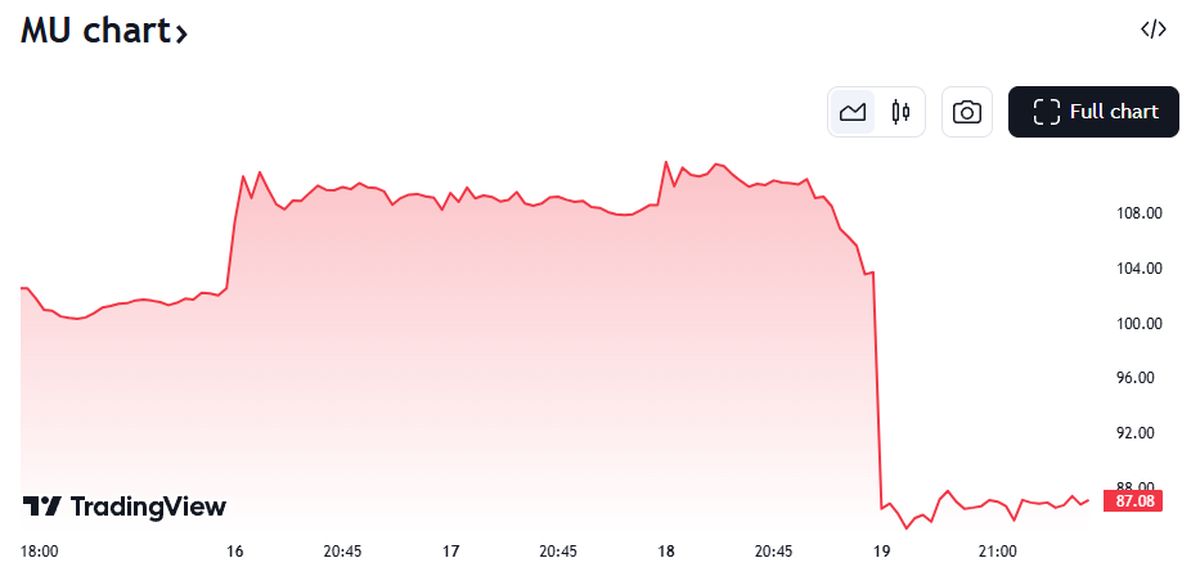Why Micron shares drop 15% overnight: An analysis

Shares of Micron Technology Inc. (MU) plunged by approximately 15% on Thursday after the chipmaker projected weak demand for its products, particularly in consumer markets. Analysts expressed concerns over Micron’s outlook, predicting adverse impacts on earnings and revenue for fiscal years 2025 and 2026.
Micron’s shares drop 15% amid weak demand forecastThe company anticipates current-quarter revenue of about $7.9 billion, significantly below previous estimates, as it grapples with a slower-than-expected PC replacement cycle and waning demand in automotive and industrial sectors. Despite earlier optimism regarding AI-related chip growth, Micron’s statement overshadowed these advancements, with analysts warning of substantial declines in both NAND flash memory and DRAM pricing, particularly due to ongoing challenges in personal computing and smartphone markets.
Bank of America analysts shifted their rating on Micron’s stock from “buy” to “neutral,” trimming their price target from $125 to $110. Concerns about weak demand in traditional segments have been voiced by various analysts. Citi, however, maintained a “buy” rating but lowered its earnings projections for 2025 and 2026, now estimating fiscal-year EPS of $6.75 and $13.31, and revenue of $34.6 billion and $45.0 billion, respectively.
Morningstar analyst William Kerwin noted that the post-pandemic market for DRAM chips faces significant headwinds, primarily stemming from diminishing consumer demand and persistent supply chain issues. Furthermore, he highlighted the lack of widespread introduction of AI-enabled devices, which could have buoyed demand.
The weaknesses in Micron’s core markets have triggered this downward spiral, leading to the company’s market capitalization potentially dropping by over $17 billion, down to approximately $99 billion. This marks a stark decline from the 22% gain Micron experienced earlier this year amid buoyant investor sentiment regarding AI chips.
 Image: TradingView
Analysts’ perspectives on Micron’s future
Image: TradingView
Analysts’ perspectives on Micron’s future
Despite the challenges, there are mixed sentiments regarding Micron’s long-term prospects. While some analysts express caution, others maintain an optimistic outlook. Wedbush Securities affirmed their “outperform” rating and a price target of $125, citing that the current headwinds are “temporal,” according to Investopedia. Their view suggests that Micron may rebound from the present difficulties, depending on improvements in market conditions.
Piper Sandler analysts highlighted that strong investments in data centers could serve as a growth pillar for Micron’s high-bandwidth memory (HBM) strategy moving into 2025, according to GuruFocus. This segment has reportedly experienced strong sequential growth, especially in DRAM for advanced AI systems. However, the recent concerns over traditional markets loom large, overshadowing these developments.
As the market assesses the overall impact of Micron’s warnings on both its stock and broader semiconductor industry, uncertainties linger. The company’s substantial reliance on consumer electronics, coupled with ongoing shifts in software platforms—like Microsoft’s phase-out of Windows 10—contributes to a complex landscape where Micron must navigate through mixed signals from the market.
The overall sentiment towards Micron reveals a precarious balance between its significant innovations in HBM technology and the stark realities presented by its exposure to struggling sectors. While Micron strives to capitalize on emerging opportunities, the prevailing uncertainty continues to shape investor apprehension and market dynamics.
Disclaimer: The content of this article is for informational purposes only and should not be construed as investment advice. We do not endorse any specific investment strategies or make recommendations regarding the purchase or sale of any securities.
Featured image credit: Micron Technology
